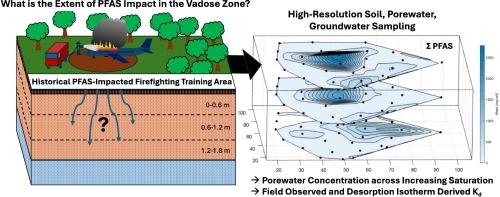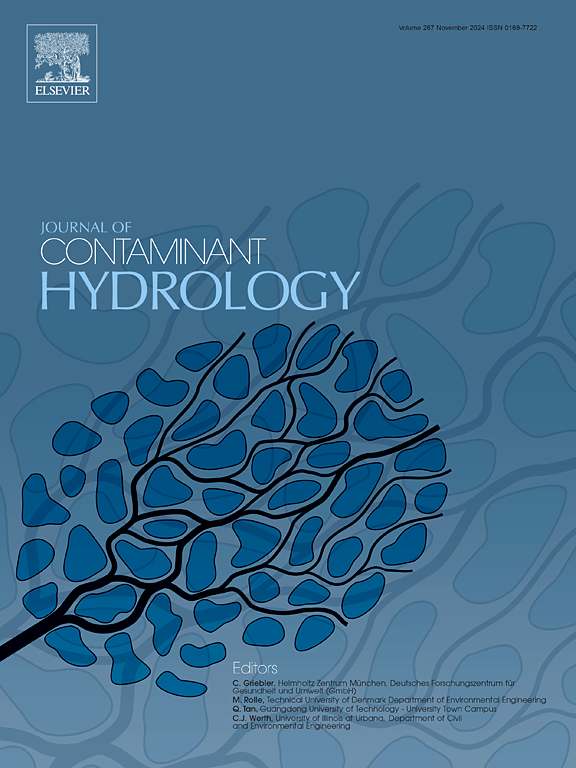基于高分辨率土壤、孔隙水和地下水采样的受afff影响的消防训练区域的PFAS概念场地模型
IF 4.4
3区 环境科学与生态学
Q2 ENVIRONMENTAL SCIENCES
引用次数: 0
摘要
在受水膜形成泡沫(AFFF)影响的前消防训练区(FTA)对渗透带土壤和孔隙水以及近下梯度地下水进行了高空间分辨率采样,以实现更准确的概念场地模型和多氟烷基物质和全氟烷基物质(PFASs)的质量分布评估。根据编制的数据集,确定了源区所有可检测到的PFASs的总质量和分布,该数据集包括28个具有多深度PFAS样本的土壤钻孔,17个多孔杯吸溶渗仪在8个月内采样3次,以及8个浅层地下水井在8个月内采样3次。PFAS分析包括目标(定量)和可疑(半定量)分析。结果表明,全氟化合物在自由区内的垂直和水平分布存在差异,大部分两性离子和阳离子前体保留在浅层土壤中。虽然在收集的土壤样品中,全氟烷基酸(PFAA)前体占全氟烷基磺酸的61%,但在孔隙水和近下梯度地下水中,全氟烷基磺酸是迄今为止占主导地位的全氟烷基磺酸类别(分别为78%和87%)。PFAS孔隙水浓度通常随着土壤含水量的增加而增加,全氟辛烷磺酸(PFOS)的这种增加可以通过基于平衡的质量平衡模型合理地描述,该模型考虑了PFAS在空气-水界面的积累和土壤-水分配。低渗透土壤内部或附近的PFAS孔隙水浓度随含水率的增加比砂质土壤孔隙水的增加更大,这可能是由于空气-水界面面积在这些细粒土壤中PFAS相分布中的作用更大。用现场材料进行的实验规模批次解吸试验显示,PFAS质量显著,不易从土壤中解吸。如果考虑到这种抗解吸PFAS质量,在现场测量到的Kd值与实验尺度数据相当。这些在FTA尺度上的新发现突出了在非均质非饱和土壤中评估PFAS孔隙水浓度和淋溶的潜在挑战。本文章由计算机程序翻译,如有差异,请以英文原文为准。

PFAS conceptual site model of an AFFF-impacted firefighting training area informed by high resolution soil, porewater, and groundwater sampling
High spatial resolution sampling of vadose zone soil and porewater as well as near downgradient groundwater at an aqueous film forming foam (AFFF)-impacted former firefighting training area (FTA) was conducted to enable more accurate conceptual site models and mass distribution assessments of poly- and perfluoroalkyl substances (PFASs). The total mass and distribution of all individual detectable PFASs in the source zone was determined from the compiled data set, which included 28 soil borings with multi-depth PFAS samples, 17 porous cup suction lysimeters sampled 3 times over 8 months, and 8 shallow groundwater wells sampled 3 times over 8 months. PFAS analyses consisted of both target (quantified) and suspect (semi-quantified) analytes. Results showed that PFASs varied in their vertical and horizontal distribution within the FTA, and that a majority of the zwitterionic and cationic precursors were retained in shallow soils. While perfluoroalkyl acid (PFAA) precursors comprised 61 % the PFASs in collected soil sample, PFAAs were by far the dominant PFAS class within both porewater and near downgradient groundwater (78 % and 87 %, respectively). PFAS porewater concentrations generally increased with increasing soil moisture content, and these increases were reasonably described for perfluorooctane sulfonate (PFOS) by an equilibrium-based mass balance model that accounted for PFAS accumulation at the air-water interface and soil-water partitioning. PFAS porewater concentrations located within or adjacent to low permeability soils showed greater increases with moisture content than in porewater associated with sandy materials, likely due to the larger role of air-water interfacial area in PFAS phase distribution in these fine-grained soils. Bench-scale batch desorption tests conducted with site material reveal a significant PFAS mass that is not readily desorbed from the soil. Observed Kd values measured in the field are comparable to the bench-scale data if this desorption-resistant PFAS mass is considered. These novel findings at the scale of an FTA highlight potential challenges with evaluating PFAS porewater concentrations and leaching in heterogeneous unsaturated soils.
求助全文
通过发布文献求助,成功后即可免费获取论文全文。
去求助
来源期刊

Journal of contaminant hydrology
环境科学-地球科学综合
CiteScore
6.80
自引率
2.80%
发文量
129
审稿时长
68 days
期刊介绍:
The Journal of Contaminant Hydrology is an international journal publishing scientific articles pertaining to the contamination of subsurface water resources. Emphasis is placed on investigations of the physical, chemical, and biological processes influencing the behavior and fate of organic and inorganic contaminants in the unsaturated (vadose) and saturated (groundwater) zones, as well as at groundwater-surface water interfaces. The ecological impacts of contaminants transported both from and to aquifers are of interest. Articles on contamination of surface water only, without a link to groundwater, are out of the scope. Broad latitude is allowed in identifying contaminants of interest, and include legacy and emerging pollutants, nutrients, nanoparticles, pathogenic microorganisms (e.g., bacteria, viruses, protozoa), microplastics, and various constituents associated with energy production (e.g., methane, carbon dioxide, hydrogen sulfide).
The journal''s scope embraces a wide range of topics including: experimental investigations of contaminant sorption, diffusion, transformation, volatilization and transport in the surface and subsurface; characterization of soil and aquifer properties only as they influence contaminant behavior; development and testing of mathematical models of contaminant behaviour; innovative techniques for restoration of contaminated sites; development of new tools or techniques for monitoring the extent of soil and groundwater contamination; transformation of contaminants in the hyporheic zone; effects of contaminants traversing the hyporheic zone on surface water and groundwater ecosystems; subsurface carbon sequestration and/or turnover; and migration of fluids associated with energy production into groundwater.
 求助内容:
求助内容: 应助结果提醒方式:
应助结果提醒方式:


